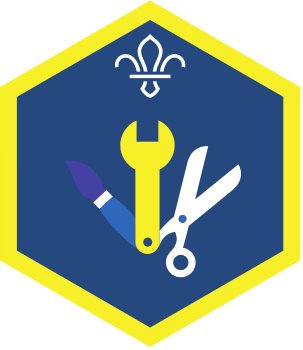Building balance
You’ll need
- Something to mark lines (for example, chalk, masking tape, or rope)
- Crash mats
- Ropes (at least two metres long)
- A ‘Twister’ game board and spinner, or homemade alternative
Before you begin
- This activity works best when run in groups of about eight people. Large groups could divide up and run the games simultaneously to each other. Just make sure you have enough leaders, adult volunteers or Young Leaders to lead each activity group.
- If you’re making your own spinner, the typical spinner in the ‘Twister’ game has 16 options. These are divided into four sections: left-hand, right-hand, left-foot, right-foot, and four subsections within each section: red, yellow, green and blue.
Run the activity
- Explain to the group that you’ll be playing the board game ‘Twister.’ The reason for this is that the game puts players in positions they have to hold, improving balance, co-ordination and core strength. Set out your game board on the floor.
- Have one person volunteer to spin the spinning dial to choose the colour. If everyone wishes to take part, the person leading the activity should spin.
- Begin the game by spinning the spinner and reading out loud the section and subsection it lands on (for example, left-hand green). Everyone should then put their left hand on a green area of the game board. More than one player may share a coloured area (or not, if you want to make it hard!).
- Continue playing in this way. Players are out if they lose their balance, and either their elbows or knees touch the game board. This is for the person spinning the spinner to judge. The last player upright and balanced is the winner.
- Next, run the game ‘squat and teeter.’ For this, everyone should get into pairs and stand half a metre apart, facing one another.
- Each player should place their feet together, bend their knees and balance on the balls of their feet, squatting as low as they can. Once players feel as if they’re balanced, they should raise their arms up, keeping them straight, in front of their chest.
- Each player should try to make their partner lose their balance. They may only touch their opponent’s hands with their own hands, though they may pull faces and make funny noises to distract them. The player who keeps their balance longest is the winner.
- Now, run the ‘rope-pulling game.’ This is like a tug of war, but between two people standing still. Each player should try to unbalance the other, or make them let go of the rope. The key is to stay in one spot, use core muscles and balance oneself to overcome the other player.
- Set out a marker in the centre of the playing area. Have each player find a partner and a rope, take an end each and stand either side of the marker, with each player one metre from it.
- Begin the contests. Players should pull on the end of the rope to try to unbalance their opponents. Anyone who lets go of their end of the rope loses out to the other player. The winner is the last person upright and balanced on their spot, who still holds the rope.
- Have anyone who’s interested in further developing their balance take a copy of the ‘Six week building balance development plan’ and the ‘Physical activity record sheet’. The former contains some activities to help improve balance, co-ordination and core strength that can be done anytime, anywhere. The latter sheet allows young people to customise their own development plan goals, which may include other agreed-upon physical skills, and set them out in a plan.
Reflection
Balance building is the aim of the game across this activity. These games have been chosen because they all present opportunities to test balance in groups. Benefits of developing balance include improved stability and a strengthened core. Enhancing one’s ability to balance can help prevent falls and similar accidents. What other sports or activities might become easier as a result of having good balance and co-ordination, as well as a strong core? How do these exercises affect our ‘posture’ (how we hold ourselves) and why might this be important too?
Safety
All activities must be safely managed. You must complete a thorough risk assessment and take appropriate steps to reduce risk. Use the safety checklist to help you plan and risk assess your activity. Always get approval for the activity, and have suitable supervision and an InTouch process.
- Contact games and activities
Make sure everyone understands what contact is acceptable, and monitor contact throughout the activity.
- Outdoor activities
You must have permission to use the location. Always check the weather forecast, and inform parents and carers of any change in venue.
- Active games
The game area should be free of hazards. Explain the rules of the game clearly and have a clear way to communicate that the game must stop when needed. Take a look at our guidance on running active games safely.
- There are many variations of the ‘Twister’ game, including playing as a team and playing a version where no two players are allowed to touch the same coloured area at the same time.
- In ‘squat and teeter,’ players could stand further apart and rely on guile alone to distract their opponents
- In the ‘rope-pulling game,’ players could have three lives, to increase the length of each contest and allow players chances to get the hang of it.
- A Twister game can be made accessible for those with visual impairments by creating textured floor markers, so that players are able to identify the positions in a tactile way. Check out this alternative take on Twister involving Braille-writing.
- More inclusive ways of practising stability and balance control include balancing a deck of cards or creating an extra-large see-saw for team balancing trials.
All Scout activities should be inclusive and accessible.
If you’re planning on working some more on your balance as part of a six-week balance development plan, find out about some new exercises, activities, stretches and games that could help. Share these with anyone else working on balance.
Young people have the option to continue developing their balance skills as part of a six-week development plan.

